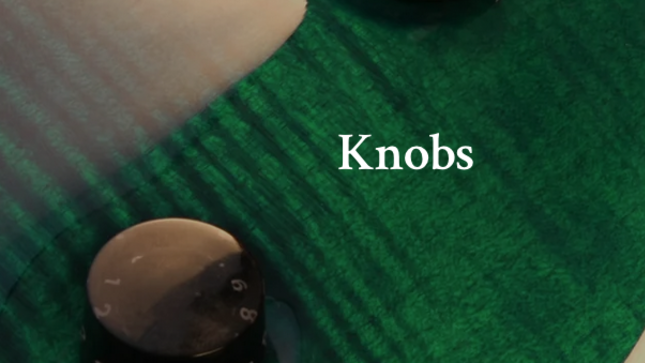
Guitar knobs – those tiny, low-profile circles of metal and plastic that sit on the body of your electric guitar – are often overlooked and underestimated. However, in practice, these knobs are the main means of obtaining a versatile number of sound colours and can significantly change the process of playing an instrument.
Whether you are playing a Les Paul or jamming on a Stratocaster, knowing the secret of guitar knobs can take you from being a very good player and making you an exceptional one. Okay, let’s look behind the scenes of these rather unassuming controls.
What Do Guitar Knobs Do?
On most electric guitars, you’ll find two main types of knobs: volume and tone. Depending on the model of the guitar, you may have just one of each or many knobs for regulating the pickups. But what is happening behind the scenes?
Volume Knob
This is the simplest of the controls. When you move the volume knob clockwise, you are increasing the signal that goes to the amplifier, and this makes your guitar sounds louder. But here’s where it gets interesting—rolling it back doesn’t just reduce volume; it changes your tone. Turning down the volume can help clear up a distorted tone, granting you a clean sound, almost like an acoustic guitar, all without adjusting your amp settings. Getting a grip of this knob can provide one with many variations of sounds without having to change equipment.
Tone Knob
This knob is especially ill-understood. It is a type of ‘switch’, but instead of switching off high frequencies altogether, it reduces them by attenuating or dampening them as you lower them. This one enables you to regulate the intensity of your sound. Use it to create sharp leads and tight rhythm; use it when you want a warm, rich sound for jazz or blues.
Some players turn it down for the rhythm sections and turn it up for solos to make their guitar ‘stand out’ or ‘pop’ in the mix.
Knobs: The hidden side of fashion
Standard guitar knobs are useful, but guitarists have learned the pleasures of custom knobs, which can be cosmetic and tonal enhancements. Many manufacturers, including Gretsch or small builders of expensive guitars, put a special “treble bleed” circuit in the potentiometer to retain high frequencies even when the volume is reduced. There are also cases when you can see two or more controls in one – stacked knobs or push-pull pots. The world of custom knobs is a door to the endless number of tonal combinations.
Knob Tweaking: A Key to Live Performance
Switching the sound in a few seconds is essential when you're on stage. While most guitarists use foot pedals and amplifiers to control their sound, your guitar controls can be even more critical in a live performance. Adjusting your volume and tone controls can save you time and prevent disruptions in your performance. Think about changing the song's mood from clean to something that would require a fast transition to a hot solo. If you can perfect knob control, these changes are smooth.
How the Position of the Knob Changes the Pickup
In case of multiple pickups, the volume and tone control knobs can be split into individual pickups. Take a Fender Stratocaster, for example; you will mostly find that you have a tone knob for the neck and another for the bridge pickup.
It is possible to have a variety of tonalities by simply turning the tone knob for only one pickup. For instance, turn the tone knob of the neck pickup to the maximum to get clear high tones and turn down the bridge pickup knob to get warmer tones. These two sources of light can help you achieve that perfect balance and get that ‘sweet spot’ tone.
Vintage vs. Modern Knobs: Does It Matter?
Some collectors of vintage guitars believe that the first generation of hand-wired pots and knobs produced in the ‘60s or ‘70s are superior in terms of feel and sound to today’s off-the-shelf models. To a lot of people, this may not seem like a big deal, but the feel of the knobs is something that veteran players can attest to. They claim that there is an interaction between the feel of the knob and the tone it creates, making them sound more natural. Regardless of your opinion, this is a fact – vintage gear is undeniably cool!
Knobs and Your Style of Play
Icons such as Jimi Hendrix and Eric Clapton were famous for touching the knobs of their guitars. It is not a secret that Hendrix used the volume and tone knobs of his Strat during a song to get different sounds from his guitar.
In the case of Clapton, he employed the tone knob to adjust the ‘woman tone’ of his Gibson SG guitar, where he rolled down the treble to achieve that vocal-like tone in his solos. Knowing how to use the knobs properly can also become your style as well in the future.
Conclusion: The Power in Your Hands
Finally, guitar knobs are much more than just the knobs that make your guitar louder or softer. They are a means of changing the tone and opening the creative process of music-making. They can help you get the best out of your guitar when used to their optimum. The next time you grab your guitar and are about to strum, take a few moments to twist those knobs and let the secret behind them unravel.
The knobs on your guitar are not merely decorative. They are passive tools, waiting for you to discover what they can do. When you do, you will find a new level to your playing that you never knew existed.